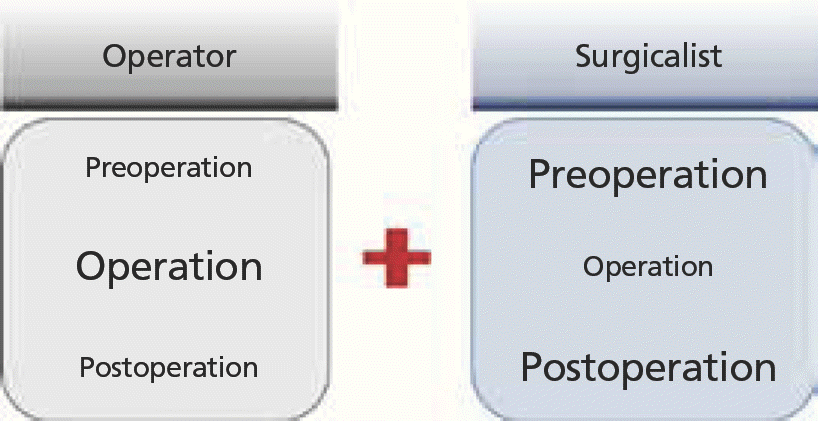Abstract
As the need for medical services increases, interest in the quality improvement of healthcare and patient safety is also increasing. This study aimed to propose a surgical hospitalist or surgicalist system in Korea. Specifically, it has been suggested that the essential capacities of the surgicalist, including their understanding of surgery, wound management, emergency management, surgical nutrition, and education, may be useful in improving the quality of healthcare and patient safety. The key characteristic of the surgicalist system is that surgeons are “readily available” in the hospital ward to provide primary care for hospitalized patients. Surgicalists provide both perioperative and advanced primary care. As the population ages, the number of high-risk patients who are undergoing major operations increases. The surgicalist system, which is responsible for the perioperative management and advanced primary care of inpatients, is expected to expand rapidly. The shift from the vertical surgeon-resident-centered system to the horizontal surgeon-surgicalist-centered system can help provide high-quality care for patients, and a systematic training system for residents. In addition, it is necessary to define the essential capacities of the surgicalist, and to determine the research and education that can promote them.
REFERENCES
1. Jang SI, Park EC, Bae HC, Shin JY, Jang SY, Choi JW, Han KT, Kim SJ, Cheon SY, Song JY. Evaluation of pilot study on the Korean hospitalist system. Seoul: Association of Evaluation of Pilot Study on the Korean Hospitalist;2016.
2. Jang SI, Park EC, Nam JM, Chae WJ, Lee NK, Kim JY, Lee JE, Cho YD. A study on the introduction of hospitalists system to improve quality of health care (phase 2). Seoul: Health Insurance Review & Assessment Service;2018.
3. Wachter RM, Goldman L. Zero to 50,000: the 20th anniversary of the hospitalist. N Engl J Med. 2016; 375:1009–1011.
4. Wachter RM, Goldman L. The emerging role of “hospitalists” in the American health care system. N Engl J Med. 1996; 335:514–517.

5. Society of Hospital Medicine. 2018 State of Hospital Medicine (SoHM) report. Philadelphia: Society of Hospital Medicine;2019.
6. Rohatgi N, Wei PH, Grujic O, Ahuja N. Surgical comanagement by hospitalists in colorectal surgery. J Am Coll Surg. 2018; 227:404–410. .e5.

7. Cheng HQ. Comanagement hospitalist services for neurosurgery. Neurosurg Clin N Am. 2015; 26:295–300.

8. Jung EJ. Essential capacities of surgicalist in Korea. In: Korean Surgical Society. Abstract book of Annual Congress of Korean Surgical Society. Seoul: Korean Surgical Society;2019. 77.
9. Kim IK, Park S, Jung EJ. Review of dressing materials for surgical wound. J Surg Infect. 2018; 3:25–29.
10. White HL, Glazier RH. Do hospitalist physicians improve the quality of inpatient care delivery? A systematic review of process, efficiency and outcome measures. BMC Med. 2011; 9:58.

11. World Health Organization. Patient safety [Internet]. Geneva: World Health Organization;2019. [cited 2019 Oct 4]. Available from:. https://www.who.int/patientsafety/en/.




 PDF
PDF ePub
ePub Citation
Citation Print
Print



 XML Download
XML Download